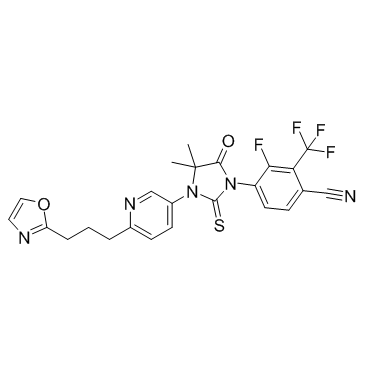Proxalutamide (GT0918) (Synonyms: GT0918; Pruxelutamide) |
| Katalog-Nr.GC33224 |
Proxalutamid (GT0918) (GT0918) ist ein oral aktiver potenter Androgenrezeptor (AR)-Antagonist. Proxalutamid (GT0918) (GT0918) kann in der Studie fÜr Prostatakrebs und COVID-19 verwendet werden.
Products are for research use only. Not for human use. We do not sell to patients.

Cas No.: 1398046-21-3
Sample solution is provided at 25 µL, 10mM.
Proxalutamide (GT0918) is a potent androgen receptor (AR) antagonist.
In biochemical assay, Proxalutamide (GT0918) more potently inhibits androgen binding with AR's ligand binding domain than Bicalutamide (11.4x) and MDV3100 (3.5x). In both hormone-sensitive (LNCaP) and CRPC (C4-2) cancer cells, Proxalutamide demonstrates stronger potency to block AR function of gene transcription than Bicalutamide (~5-10) and MDV3100 (2-5x) while maintaining full antagonism in CRPC cells. Proxalutamide impairs androgen stimulates AR translocation to cell nuclei hence blocks its binding DNA and shuts down the downstream oncogenic signaling. Moreover, Proxalutamide induces AR down regulation in prostate cancer cells. Proxalutamide not only inhibits proliferation of hormone-sensitive CaP cells, but also more potently inhibits proliferation of CRPC cells. In addition, Proxalutamide inhibits the growth of AR positive breast cancer cells. In contrast, Proxalutamide has minimum effects on the growth of AR-negative CaP cells (PC-3 and DU145), indicating it is a selective AR pathway inhibitor[1].
The major pharmacokinetic parameters and statistical moment parameters are summarized. The tmax for the pHM-SD and conventional tablets are 0.9±0.4 h and 2.5±1.1 h, respectively, meaning that the pHM-SD tablets dissolve more quickly than the conventional tablets. Moreover, the difference between the tmax of the two treatments is statistically significant (p<0.05). The mean Cmaxand the AUC0-36 are 5.1±2.4 μg/mL and 38.3±8.2 μgh/mL for the pHM-SD tablets versus 3.1±1.5 μg/mL and 42.1±22.3 μgh/mL for conventional tablets, respectively. The relative bioavailability (frel) of the pHM-SD tablets is 125.6% of that for the conventional tablets on average, revealing that the bioavailability of the former is higher. The mean Proxalutamide (GT0918) half-life estimate from the pHM-SD tablets (7.9±2.2 h) was similar to that of the conventional tablets (8.4±0.5 h), remaining consistent with the following pharmacoki-netic theory: the extent and rate of absorption should not affect elimination[2].
[1]. Youzhi Tong, et al. Abstract 614: Proxalutamide (GT0918), a potent androgen receptor pathway inhibitor. Cancer Research. AACR Annual Meeting 2014; April 5-9, 2014; San Diego, CA. [2]. Yang M, et al. Microenvironmental pH-modified solid dispersions to enhance the dissolution and bioavailability of poorly water-soluble weakly basic GT0918, a developing anti-prostate cancer drug: preparation, characterization and evaluation in vivo. Int J Pharm. 2014 Nov 20;475(1-2):97-109.
Average Rating: 5 (Based on Reviews and 27 reference(s) in Google Scholar.)
GLPBIO products are for RESEARCH USE ONLY. Please make sure your review or question is research based.
Required fields are marked with *




















